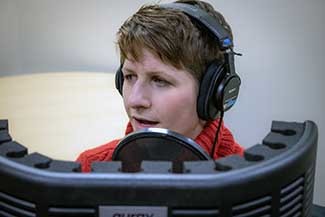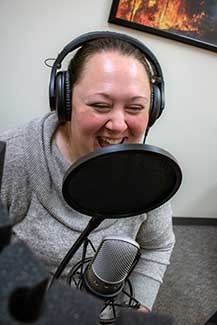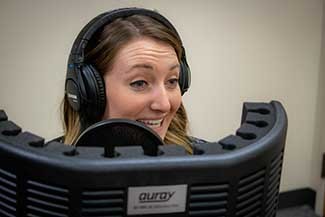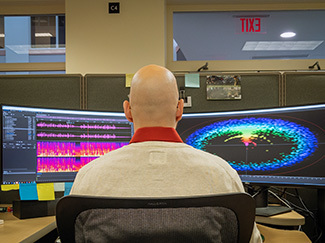Behind the scenes of the 'Wildtalk' podcast
By HANNAH SCHAUER
Michigan Department of Natural Resources

“Mics are hot!” I said as I hit the record button.
It was a Friday afternoon. My coworkers Holly and Rachel and I were gearing up to record the latest episode of the Michigan Department of Natural Resources’ “Wildtalk” podcast.
After we did our sound checks and had reviewed the topics we were going to cover, we were ready to record.
New “Wildtalk” episodes are released the first day of each month and cover an array of wildlife- and habitat-related topics.
The podcast includes discussions on the DNR Wildlife Division’s work underway and gives listeners a snapshot of wildlife conservation efforts happening throughout the state.
For example, the most recent episode includes an interview with wildlife biologist Karen Cleveland about her role in creating games as a fun way to educate people about Michigan wildlife. It also features updates from around the state about the winter wolf population survey, various hunting seasons and more; answers to questions about topics including furbearer registration and the spring turkey hunting application period; and a discussion about winter wildlife-watching opportunities and animal track identification.
Since the podcast’s debut in June 2018, 20 episodes have been released. You can check them out on the Wildtalk Podcast webpage.
How ‘Wildtalk’ began
“We are always looking for innovative ways to share work the division does more broadly,” said podcast host Holly Vaughn, manager of the DNR Wildlife Division’s Public Outreach and Engagement Unit. “Wildlife conservation efforts impact everyone in one way or another.”
While brainstorming new ideas for getting information to our audiences, creating a podcast reached the top of the list of potential new tools. Podcasts – which are digital recordings often shared in a serial format – are incredibly popular and are something the DNR hadn’t used in the past.
Why not give it a try?
|

But none of us had any experience creating a podcast. We all have our favorite podcasts we enjoy listening to but didn’t know how we would create one of our own.
Recording an episode
As the hosts, Vaughn, DNR wildlife outreach coordinator Rachel Leightner and I brainstorm ideas for topics to cover each month.
One of my favorite things about hosting the podcast is every time we’re pulling the episode together or interviewing our guest, I learn something new.
We solicit input from division staff on key topics to discuss for upcoming episodes. In fact, the “Around the State” segment is made up of updates we get from field staff on the work they are doing.
We also reach out to potential interview guests who have a background or expertise in the topic we’d like to discuss.
“With the complexity and depth of Michigan’s natural resources, there is no shortage of interesting conversations to dive into,” podcast host Leightner said.
“From the benefits of prescribed burns for landscapes, to how hunting regulations are determined, to creating actual games that are fun, cutting-edge tools to teach children ecosystem and conservation principles, the podcast’s intent is to broadcast the amazing work of the DNR Wildlife Division throughout the state.”
If you hadn’t already guessed, Leightner’s favorite portion of the show is the guest interview.
|

“I love chatting with our guests,” she said. “There is always so much to learn from them and hearing their personal stories – about the work they do or their favorite outdoor pastime – is really a lot of fun.”
Vaughn likes that the “Around the State” segment comes right at the beginning of the show.
“It is a great way to kick off the episode and talk about the latest happenings in each region of the state,” she said. “There is always something interesting keeping our staff busy.”
It would be safe to say I have a soft spot for the “Mailbag” segment.
I enjoy answering people’s questions on air and being able to dive into a little more detail than I can in an email response. And I’m hopeful that it might help clarify similar questions other folks have about that topic.
Producing the final product
Back in the recording studio, I asked, “Should we start at the beginning, or do you ladies want to switch it up a bit?”
We don’t always record the episode’s segments in order, or all on the same day for that matter. We record when it fits with our interview guests’ schedules as well as times when we can set up our makeshift studio.
When we find a time that works for recording, I commandeer a conference room and transform it into a studio complete with microphones and recording equipment.
We’ve become a well-oiled machine, and it doesn’t take us long to get situated.
|

Once we’ve recorded all the show segments and have interviewed our guest for that month, the next steps are in the hands of the show’s producer, Eric Hilliard.
When the recording files get to his desk, Hilliard, the division’s digital media specialist, makes the magic happen.
If you asked him about the production and editing of the podcast, he would say he “tosses it in a blender and the end result is a podcast.”
I think he sells himself a bit short, as it is no easy feat listening to the raw recordings multiple times in order to tweak the audio and assemble it into a flawless-sounding final product.
I’ve sat at his desk once or twice to help listen to some audio, and it requires patience and a well-trained ear. Each episode takes six to eight hours to edit.
Hilliard also crafts and produces the show’s advertisements and the accompanying show notes and transcripts.
Diversity of listeners
“This modern platform has provided us a way to further expand communication with diverse audiences,” Hilliard said. “So diverse, some listeners tune in from around the world. Canada, United Kingdom, Germany and France are among the podcast’s top listening countries.”
On average, 2,100 listeners plug in to each episode.
Since the podcast first aired, there have been over 41,000 total listens across all episodes.
Most listeners are Michigan-based, tuning in from Grand Rapids, Lansing, Detroit and Kalamazoo.
Surprisingly, the largest listener presence in the United States hails from Cleveland, Ohio.
How to listen
“Wildtalk” is available on the iTunes Store, Google Play Music and other popular podcatchers, as programs used to download podcasts are known.
You also can listen online. Visit Michigan.gov/Wildlife and look under “Inside Wildlife Division” for the Wildtalk Podcast link. On the podcast page, you’ll also find show notes and transcripts for each episode.
If you’d like to contact the hosts of the Wildtalk Podcast, you can find us at DNR-Wildlife@michigan.gov or 517-284-WILD (9453).
|
Check out previous Showcasing the DNR stories in our archive at Michigan.gov/DNRStories. To subscribe to upcoming Showcasing articles, sign up for free email delivery at Michigan.gov/DNR.
/Note to editors: Contact: John Pepin, Showcasing the DNR series editor, 906-226-1352. Accompanying photos and a text-only version of this story are available below for download. Caption information follows. Credit Michigan Department of Natural Resources, unless otherwise noted.
Text-only version of this story.
Hilliard: “Wildtalk” producer Eric Hilliard combs through the recorded audio to create a polished final product.
Hosts: Left to right, “Wildtalk” podcast hosts Rachel Leightner, Holly Vaughn and Hannah Schauer chat about what is happening with wildlife this month.
Leightner: Host Rachel Leightner shares an answer to a question during the “Mailbag” portion of the podcast.
Schauer: Hannah Schauer shares a few final thoughts with the audience to wrap up a “Wildtalk” episode.
Vaughn: Holly Vaughn, foreground, chats about what is going on around the state with Hannah Schauer, background, for one of the podcast’s regular segments.
Vaughn-2: Holly Vaughn introduces the topics for an episode of the show./
|